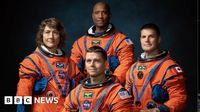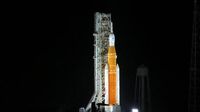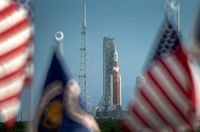After years of anticipation, technical setbacks, and a renewed sense of urgency, NASA is on the cusp of launching Artemis II—the first crewed mission to the Moon in more than half a century. In a series of announcements and press briefings this week, agency officials confirmed that the long-awaited flight could take place as early as February 5, 2026, moving up the timeline by two months from previous estimates. If all goes according to plan, four astronauts—Reid Wiseman, Victor Glover, Christina Koch, and Jeremy Hansen—will embark on a 10-day journey that will see them circle the Moon and return safely to Earth, marking the first time humans have left low-Earth orbit since the Apollo 17 mission in December 1972, according to NASA and coverage by EL PAÍS and Futurism.
The Artemis II mission is more than just a symbolic return to the Moon. It’s a pivotal test flight for NASA’s ambitions to establish a permanent human presence on the lunar surface and, eventually, to use the Moon as a springboard for Mars exploration. The mission will test critical systems—most notably the life support technologies and operational procedures that will be essential for the next step: landing astronauts on the Moon itself during Artemis III, now scheduled for no earlier than 2027.
The hardware for Artemis II is rapidly nearing readiness. The agency’s powerful Space Launch System (SLS) rocket has been stacked and declared fit for flight. The Orion crew capsule is in the final stages of preparation, with plans to attach it to the SLS later this year. Early in 2026, the combined rocket and spacecraft will roll out to the launch pad at Kennedy Space Center, where they’ll be connected to ground systems and undergo a rigorous “wet dress rehearsal.” This rehearsal will see the rocket fully fueled with liquid hydrogen and oxygen, and the countdown taken down to just 29 seconds before liftoff—essentially a full simulation of launch day without actually leaving the ground, as explained by Artemis launch director Charlie Blackwell-Thompson.
Once the launch window opens on February 5, 2026, and weather and technical conditions align, Artemis II will take flight in what’s expected to be an evening launch. After liftoff, the Orion capsule will separate from the SLS upper stage about three hours into the mission, then spend roughly 24 hours in Earth orbit. During this phase, the astronauts will perform a battery of checkouts to ensure that life support, thrusters, and other vital equipment are functioning exactly as needed.
Following these critical tests, the crew will ignite Orion’s engines and set course for the Moon, embarking on a round-trip spanning more than 1.2 million miles. They’ll complete a single lunar orbit, passing as close as 4,350 miles (7,000 kilometers) from the Moon’s surface. This will offer them a unique view of the Moon’s far side—a sight few humans have ever witnessed. NASA has even simulated these views in a time-lapse video, giving the public a taste of what the astronauts will experience.
But Artemis II isn’t just about the United States flexing its technological muscles. For the first time, the U.S. is heading to the Moon in close partnership with international allies. The Artemis II crew includes Canadian astronaut Jeremy Hansen, and the Orion service module—responsible for air, water, electricity, propulsion, and thermal control—was built by European companies selected by the European Space Agency. This spirit of collaboration is a marked departure from the Cold War-era Apollo program, reflecting a new era of shared exploration and technological exchange.
“Let me emphasize that this is a test flight, and so the activities that we do together, we are going to learn from them,” said Lakiesha Hawkins, NASA’s acting deputy associate administrator, during a recent mission update quoted by the Orlando Sentinel. “While Artemis 1 was a great success, there are new systems and new capabilities that we will be demonstrating on Artemis 2, including the life support systems, the display capabilities, software, etc.”
NASA’s leadership has made no secret of the geopolitical stakes involved. With China making rapid strides toward its own lunar ambitions—aiming to land astronauts on the Moon by 2030—there’s a palpable sense of competition reminiscent of the original space race. “We are going to beat the Chinese to the Moon,” NASA acting administrator Sean Duffy told employees at a recent town hall. “We are going to make sure that we do this safely. We’re going to do it fast. We’re going to do it right.” Hawkins echoed these sentiments, noting, “There is a desire for us to return to the surface of the moon and to be the first to return to the surface of the Moon.”
Yet, the path to Artemis II hasn’t been smooth. The mission has already weathered two significant delays, with the original launch target slipping from late 2025 to April 2026, before this week’s announcement moved the timeline up to February. Technical hurdles have abounded, including a notable issue with the Orion capsule’s heatshield after the Artemis I uncrewed test flight in 2022. NASA identified the technical cause of the damage late last year and has since worked to resolve it, determined to ensure crew safety for Artemis II.
Political headwinds have also complicated matters. The arrival of Donald Trump in the White House in 2025 brought both renewed support for crewed exploration and proposed deep cuts to NASA’s science budget. While the president’s administration has outwardly championed the Artemis program, plans to reduce funding for related projects—such as the future Gateway lunar station—sparked pushback from Congress. In July, the Gateway project was reinstated as part of a political compromise, highlighting the delicate balance between ambition and fiscal reality.
Despite these challenges, NASA continues to push forward. The Artemis program’s long-term vision includes not just lunar landings, but also the deployment of a lunar-orbiting space station (Artemis IV) and, eventually, crewed missions to Mars. The international partnerships forged for Artemis II are expected to deepen, with Europe and Canada playing increasingly vital roles in future missions.
In a sign of changing times, NASA introduced its newest class of astronauts on September 22, 2025, with more women than men for the first time in agency history. Among them is Anna Menon, a SpaceX engineer and veteran of the private Polaris Dawn mission in 2024. Senator Ted Cruz, present at the announcement, remarked, “I am particularly proud of all the women here, and the fact that through Artemis, America is going to put the first woman on the surface of the Moon in the history of mankind.” Artemis III, the next step after Artemis II, aims to land the first woman and the first person of color on the Moon—a milestone that remains a source of pride, even as official emphasis on the goal has fluctuated.
As the countdown to February 2026 begins, NASA faces a daunting checklist of final preparations, system tests, and political wrangling. But with Artemis II, the agency is closer than it’s been in decades to sending humans back to the Moon—and this time, the world will be watching every step of the way.


